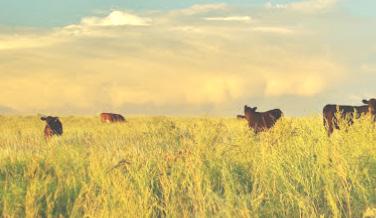
1 minute read
‘Heartbreak’ on
By: Dr. Joe Neary, Department of Animal and Food Sciences, Texas Tech University

There’s a disease that causes cattle to die of a ‘broken’ heart: right-sided congestive heart failure (RHF) or, more commonly, brisket disease. This heartbreak, however, has nothing in common with cowboy romance novels–sorry to disappoint those of you hoping for a soppy love story in Protein Producers. Instead, the heart ‘breaks’, or fails, due to exhaustion. The disease starts when the blood vessels, or pulmonary arteries, that transport blood from the rightside of the heart to the lungs, begin to restrict flow. This increases the workload on the heart; just like a blocked irrigation pipe increases the workload on the water pump; if the blockage is not removed, the pump will fail.
The difference between right heart failure (brisket disease) and other causes of heart failure
Brisket disease or RHF should not be confused with other causes of heart failure. These other causes affect specific areas of the heart:
• Pericarditis: inflammation of the pericardium, the outside of the heart. Hardware disease is a common example
• Myocarditis: inflammation of the myocardium, the wall of the heart. Haemophilus somni infection of the left ventricle is one example
• Endocarditis: inflammation of the endocardium, the inside lining of the heart. Bacterial colonization of the
Brisket disease differs from the above heart diseases because, unlike the above, the disease does not involve a specific area of the heart. Rather, the entire right-heart is involved due to narrowing of vessels downstream, in the pulmonary arteries–this is technically called cor pulmonale. Importantly, the above diseases can produce similar lesions to RHF on necropsy examination; consequently, the heart must be closely examined for other possible causes of heart failure.
Low oxygen levels in the lung cause right heart failure or brisket disease
So why do the pulmonary arteries begin to narrow and restrict flow? For 3 possible reasons: 1) High altitude exposure, 2) Diseases of the lung such as pneumonia, and 3) Slow or shallow breathing. All 3 factors can trigger the disease through one common mechanism: they reduce the amount of oxygen entering into the lung.
The low levels of oxygen cause the pulmonary arteries to contract and narrow; this increases the resistance to blood flow–just like a blocked irrigation pipe–and causes the blood pressure in the pulmonary arteries to rise. This is why cattle that have a high pulmonary arterial pressure (PAP)–greater than 49 mm Hg–are thought to be at greatest risk of brisket disease.1 Cow-calf producers in the high country (> 7,000 ft) will typically only keep








